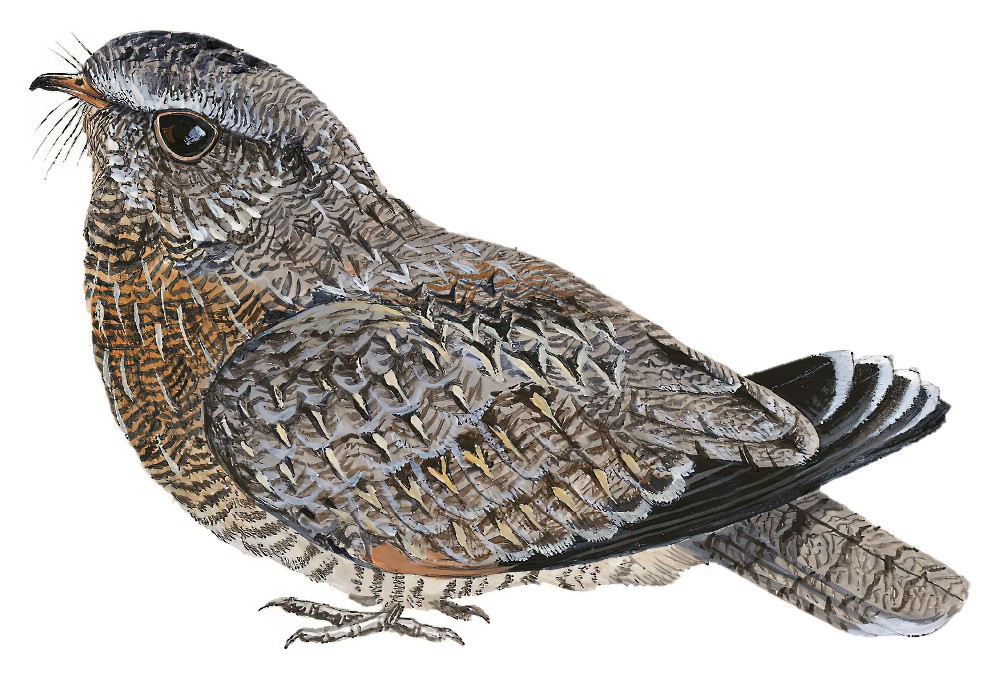Sickle-winged Nightjar / Eleothreptus anomalus

Sickle-winged Nightjar
SCI Name:
Protonym: Amblypterus anomalus Proc.Zool.Soc.London(1837) (1837), Pt5 no.58 p.105
Taxonomy: Caprimulgiformes / Caprimulgidae / Eleothreptus
Taxonomy Code: siwnig1
Type Locality: Demerara, error = Sao Paulo, Brazil, by designation of Pinto, Rev. Mus. Paulista, 32, 1938, p. 237.
Author: Gould
Publish Year: 1838
IUCN Status: Near Threatened
DEFINITIONS
ELEOTHREPTUS
(Caprimulgidae; Ϯ Sickle-winged Nightjar E. anomalus) Gr. ἑλεοθρεπτος heleothreptos marsh-bred < ἑλος helos, ἑλεος heleos marsh; τρεφω trephō to nourish; "Eleothreptus ... Obs. Nomen: ελεον, misere, vel mensa culinari, et θρεπτος, nutritus. Si a vocab. ἑλος (palus) derivaretur, ἑλειοθρ . . v. ἑλωθρ . . et latine Heleiothr. vel Helothr. scriberetur" (Sundevall 1872); "ELEOTHREPTUS, n. Amblypterusa, Gould. E. anomalus, (Gould,) n. Gould, Icon. Av. II. pl. aSimilar to a word used in Entomology." (G. Gray 1840); "Eleothreptus G. R. Gray, List Gen. Bds., 1840, p. 7. New name for Amblypterus Gould, 1838. Type, by original designation and monotypy, E. anomalus (Gould) = Amblypterus anomalus Gould.1 ... 1 Gray believed Gould's generic name to be "similar to a word used in entomology" referring no dount to Amblyptera Solier, 1836. There is however a genus of fossil fishes, Amblypterus Agassiz, 1833 of which Gould's name is a homonym." (Peters, 1940, IV, p. 220).
Var. Eleothreptes, Heleothreptus.
Synon. Amblypterus.
anomalus
L. anomalus anomalous, irregular, deviating from the rule < Gr. ανωμαλος anōmalos uneven, strange, inconsistent, deviant < negative prefix αν- an- ; ομαλος omalos even.
• "48. CALLENE ANOMALA, sp. n. ... This species is quite distinct in coloration from all its allies." (Shelley 1893) (Dessonornis).
• "Mr. Gould introduced to the notice of the Meeting a very singular form among the Caprimulgidæ ... AMBLYPTERUS ANOMALUS. ... Mr. J. E. Gray believes this bird to be from Demerara, or the Brazils; the specimen is in the collection at the British Museum, and so far as I am aware is unique." (Gould 1838) (Eleothreptus).
• "EUBUCCO BOURCIERI ANOMALUS, subsp. nov. ... Another discovery of geographic interest, as this genus has hitherto been unknown between western Panama and Colombia. It is rather surprising to find how closely salvini of Central America and occidentalis of western Colombia resemble each other, the color characters separating them being obviously only in series. Between them geographically comes anomalus of eastern Panama, a very different bird, more closely allied in certain respects to typical bourcieri." (Griscom 1929) (subsp. Eubucco bourcierii).
• "SCLERURUS MEXICANUS ANOMALUS, subsp. nov. ... This form, which usually has been referred to S. m. mexicanus in spite of the fact that a much darker subspecies, C.[sic] m. pullus Bangs, occurred in Costa Rica and Chiriqui cutting the range in two, appears to be quite distinct. It differs from true mexicanus conspicuously" (Bangs & Barbour 1922) (syn. Sclerurus mexicanus andinus).
• "89. Crateropus plebejus anomalus subsp. nov. ... These birds differ much from all other African Crateropi, and it was Alexander's intention to describe them as a new species, as shown by a manuscipt name on the labels. If all the other forms which are now treated as subspecies of C. plebejus are forms of it, then this new form must also be one of them." (Hartert 1921) (syn. Turdoides plebejus).
• "45. Zosterops anomala n. sp. Zosterops Z. palpebrosae Temm. similis, sed annulo periophthalmico nudo, sine plumis albis, exterius annulo ex plumis nigris circumdato; tibiis albescentibus, abdomine concoloribus." (Meyer & Wiglesworth 1896) (Zosterops).
• see anomala
UPPERCASE: current genus
Uppercase first letter: generic synonym
● and ● See: generic homonyms
lowercase: species and subspecies
●: early names, variants, mispellings
‡: extinct
†: type species
Gr.: ancient Greek
L.: Latin
<: derived from
syn: synonym of
/: separates historical and modern geographic names
ex: based on
TL: type locality
OD: original diagnosis (genus) or original description (species)












